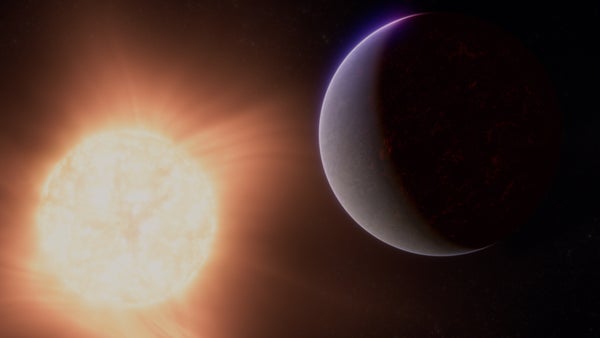In a First, JWST Confirms an Atmosphere on a Rocky Exoplanet
In a First, JWST Confirms an Atmosphere on a Rocky Exoplanet
Milestone observations from the James Webb Space Telescope reveal signs of an atmosphere on the inhospitably hot super-Earth 55 Cancri e

An artist’s concept of the rocky exoplanet 55 Cancri e, based on measurements from NASA’s James Webb Space Telescope and other observatories which suggests the world has a significant, carbon-rich atmosphere.
NASA, ESA, CSA, Ralf Crawford (STScI)
Astronomers say that they have used the James Webb Space Telescope (JWST) to detect for the first time an atmosphere surrounding a rocky planet outside the Solar System. Although this planet cannot support life as we know it, in part because it is probably covered by a magma ocean, scientists might learn something from it about the early history of Earth — which is also a rocky planet and was once molten.
Finding a gaseous envelope around an Earth-like planet is a big milestone in exoplanet research, says Sara Seager, a planetary scientist at the Massachusetts Institute of Technology in Cambridge who was not involved with the research. Earth’s thin atmosphere is crucial for sustaining life, and being able to spot atmospheres on similar terrestrial planets is an important step in the search for life beyond the Solar System.
The planet investigated by JWST, called 55 Cancri e, orbits a Sun-like star 12.6 parsecs away and is considered a super-Earth, a terrestrial planet a little bigger than Earth — in this case, with about twice Earth’s radius and more than eight times as heavy. According to a paper published today in Nature, its atmosphere is probably rich in carbon dioxide or carbon monoxide and has a thickness that is “up to a few per cent” of the planet’s radius.
On supporting science journalism
If you’re enjoying this article, consider supporting our award-winning journalism by subscribing. By purchasing a subscription you are helping to ensure the future of impactful stories about the discoveries and ideas shaping our world today.
A mysterious planet
Another reason that 55 Cancri e is uninhabitable is that it is very close to its star — around one sixty-fifth of the distance from Earth to the Sun. And yet, “it’s perhaps the most studied rocky planet”, says Aaron Bello-Arufe, an astrophysicist at the Jet Propulsion Laboratory (JPL) in Pasadena, California, and a co-author of the paper. Its host star is bright in our night sky, and because it is large for a rocky planet, it’s easier to study than other planets outside the Solar System. “Every telescope or instrument that you can think of in astronomy has pointed to this planet at some point,” Bello-Arufe says.
55 Cancri e was so well studied that after JWST launched in December 2021, engineers pointed the observatory’s infrared spectrometers towards it for testing. These instruments can detect the chemical fingerprints of gases swirling around planets as they absorb infrared wavelengths from starlight. Bello-Arufe and his colleagues then decided to dig deeper to confirm whether the planet had an atmosphere.
Before the latest observations, astronomers had changed their minds about 55 Cancri e myriad times. The planet was discovered in 2004. At first, researchers thought it was probably the core of a gas giant similar to Jupiter. But in 2011, the Spitzer Space Telescope observed the planet as it passed in front of its star, and researchers found that 55 Cancri e is in fact a lot smaller and denser than a gas giant, making it a rocky super-Earth.
Some years later, researchers noticed that 55 Cancri e was cooler than it should have been for a planet so close to its star, indicating that it probably has an atmosphere. One hypothesis was that the planet is a ‘water world’ enveloped by supercritical water molecules; another was that it is surrounded by an expansive, primordial atmosphere composed mainly of hydrogen and helium. But these ideas were eventually disproved.
A planet so close to its star would be bombarded by stellar winds and have a hard time holding on to volatile molecules in its atmosphere, says Renyu Hu, a planetary scientist at JPL and a co-author of the latest study. Two possibilities remained, he says. The first was that the planet is completely dry, with an ultrathin atmosphere of vaporized rock. The second was that it has a thick atmosphere composed of heavier, volatile molecules that do not bleed away easily.
A clearer picture
The latest data indicate that 55 Cancri e’s atmosphere contains carbon-based gases, pointing to option two. The team collected bona fide evidence of an atmosphere, Seager says, but more observations are needed to determine its full composition, the relative quantities of gases present and its precise thickness.
Laura Schaefer, a planetary geologist at Stanford University in California, is interested in learning how 55 Cancri e’s atmosphere interacts with materials beneath the planet’s surface. It’s still possible that the atmosphere is being eroded by stellar winds, the study’s authors say, but the gases could be getting replenished by the melting and outgassing of rocks in the magma ocean.
“Earth probably went through at least one magma-ocean stage, maybe several,” Schaefer says. “Having actual present-day examples of magma oceans can help us understand the early history of our Solar System.”
This article is reproduced with permission and was first published on May 8, 2024.


